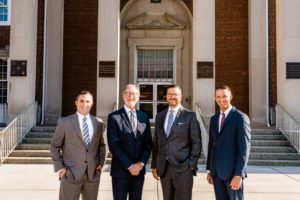Pedestrians have no protection against the force, weight, and speed of motor vehicles, which can result in severe injuries in the event of an accident. If the negligence of drivers or others led to you being injured in this type of collision, you might wish to engage the services of an Altoona pedestrian accident lawyer.
A dedicated personal injury attorney could focus on negotiating with insurance companies and filing a legal claim while you concentrate on your physical recovery.
 Distracted driving is a major cause of pedestrian accidents, which may result in fatalities. Drivers may not see pedestrians, traffic signs or signals, or other vehicles when talking or texting on their cell phones. Using the GPS function on cell phones, searching for information about a destination, browsing social media, watching videos, and searching for music are common distractions that may lead to disaster.
Distracted driving is a major cause of pedestrian accidents, which may result in fatalities. Drivers may not see pedestrians, traffic signs or signals, or other vehicles when talking or texting on their cell phones. Using the GPS function on cell phones, searching for information about a destination, browsing social media, watching videos, and searching for music are common distractions that may lead to disaster.
Another common cause of pedestrian accidents is impairment by alcohol or drugs. Drivers who are impaired by alcohol or drugs may have delayed reaction times and poor motor skills, which can make them incapable of stopping for pedestrians.
Pedestrians have no safety mechanisms such as those that protect the occupants of motor vehicles. As a result, pedestrians may experience devastating injuries due to these crashes, including spinal cord injuries, fractured bones, traumatic brain injuries, and internal injuries. A skilled pedestrian accident lawyer in Altoona may be able to work with injury victims to build substantial injury claims against the parties that are responsible for causing the injuries.
Regardless of the specific cause of a pedestrian accident, the most important aspect of an ensuing lawsuit is proving that the defendant was legally negligent. More specifically, a plaintiff must show that the defendant named in the case violated a duty of care in a way that directly led to his or her accident and subsequent injuries.
Many different traffic violations and/or careless actions could constitute a breach of the duty of care drivers owe to everyone on the road. However, holding a reckless or careless driver financially liable for an accident requires proving through a preponderance of evidence that a specific reckless or careless act directly caused the losses for which the plaintiff is seeking compensation.
If a pedestrian accident victim can establish civil fault based on a legal theory of negligence, the responsible party may be liable to pay for a number of different damages. Recoverable economic damages—which are those that have objective financial values—commonly include medical expenses, past and future wage loss, and costs related to property damage.
Conversely, non-economic damages, those that do not have objective dollar values supported by documentary evidence, may include physical pain, emotional distress, loss of enjoyment of life, and permanent impacts stemming from a newfound disability and disfigurement. Punitive damages meant specifically to punish the defendant may also be available, but only in rare cases involving reckless conduct by the defendant, such as drunk driving, speeding in a construction zone, or texting while driving.
Importantly, defendants are not the only parties who can bear negligence in a pedestrian accident claim. If an accident victim contributed to causing his or her own damages in some way, such as by stepping out into the street suddenly or failing to obey crosswalk laws, the victim may have the final damage award proportionately reduced by his or her assigned degree of fault. For instance, if the victim herself was 15% to blame for causing the accident, then her award would be reduced by 15% to account for her own portion of fault. Additionally, any plaintiff found more at fault than the defendant (i.e. 51% or more) will be ineligible to recover anything at all.
42 P.S. § 5524 sets forth the general statute of limitations for lawsuits, including personal injury claims. A statute of limitations is a legal deadline by which individuals must file a lawsuit, or risk forfeiting their right to any recovery. Generally, individuals must file personal injury claims within two years of the date of the accident that led to their injuries.
In certain circumstances, there are other deadlines with which an injury victim must comply in order to preserve their right to pursue just compensation. For instance, if a city bus driver was speeding and collided with a pedestrian, the city may be liable in any personal injury claim that ensues. Persons who may have claims for damages against government entities, such as cities, townships, school districts, or Commonwealth entities, such as PennDOT, must file a notice of intent to sue with those entities no more than six months from the date of the accident. This six-month requirement for serving a written notice is in addition to the general statute of limitations for filing a lawsuit.
Failing to meet the appropriate statute of limitations and other notice requirements may result in a complete inability to pursue any claim for damages resulting from an accident. Contacting a well-practiced pedestrian accident attorney in Altoona may be helpful to ensure that injury victims meet the relevant statute of limitations.
 Contact an Altoona Pedestrian Accident Attorney for Guidance
Contact an Altoona Pedestrian Accident Attorney for GuidanceDetermining fault and providing negligence in pedestrian accident cases can be challenging. Since a pedestrian likely will be focused on recovering from his or her injuries following an accident, the assistance of an Altoona personal injury lawyer may be invaluable. Allowing legal counsel to pursue a claim on your behalf may permit you to put your efforts toward getting well, while still getting the compensation that you need. Contact us to speak to the diligent lawyers at Marcus & Mack today.
By: Luke R.
 1216 11th Ave Suite 219
Altoona
PA
16601
Phone: (814) 942-9443
1216 11th Ave Suite 219
Altoona
PA
16601
Phone: (814) 942-9443